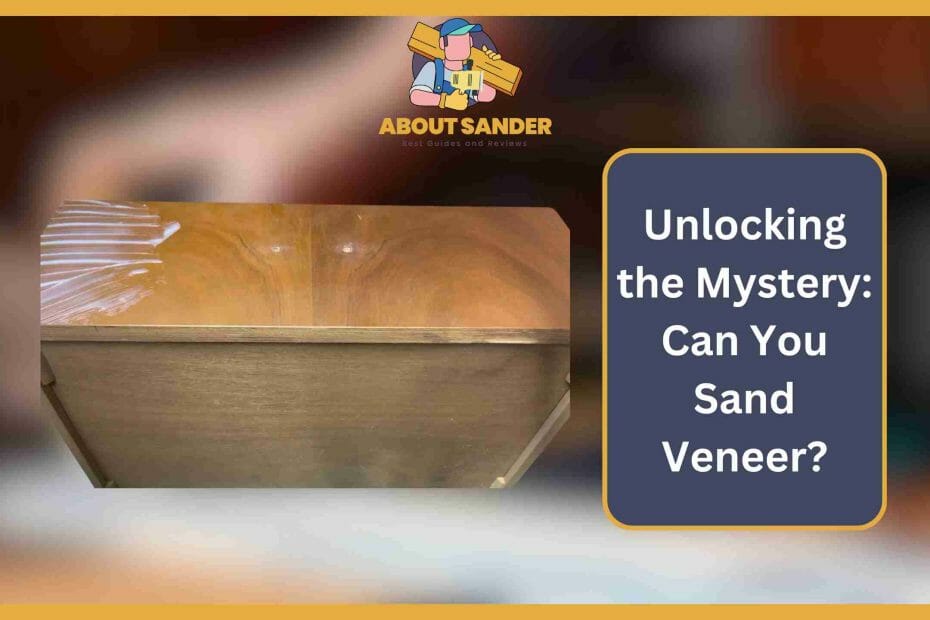Can You Sand Veneer? Yes, You can Sand Veneer, but it requires a delicate touch as it is a thin layer of wood applied to another surface. Sanding veneer can easily damage or remove the thin layer of wood if not done carefully.
When sanding veneer, it’s essential to use fine-grit sandpaper to avoid scratching or damaging the veneer’s surface.
In this guide, you will get the exact methods and tips to sand veneer.
Key Takeaways:
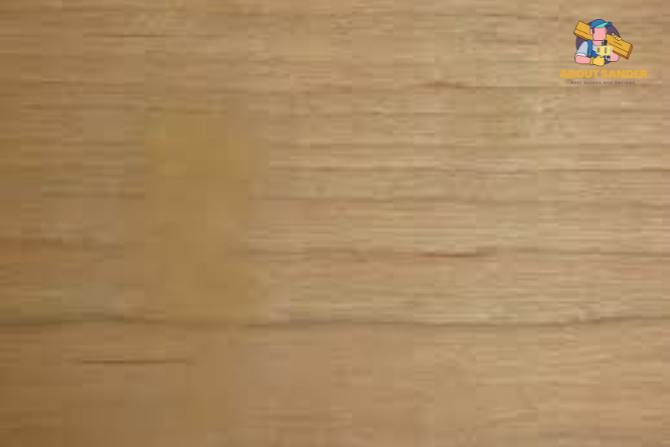
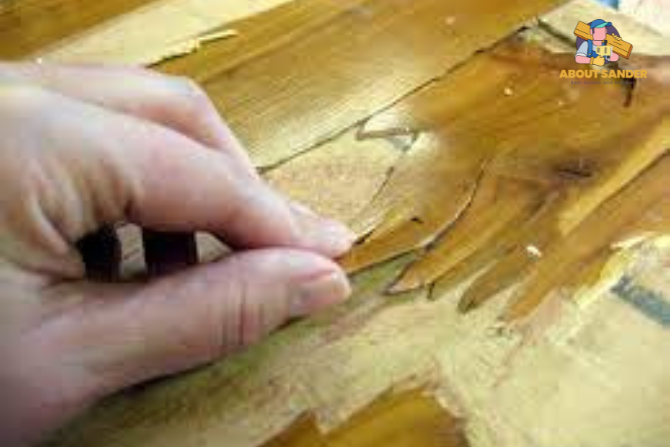
- Veneer and laminate are two different materials, with veneer being a thin layer of real wood and laminate being a synthetic material made to look like wood.
- There are several types of veneer, including rift cut, rotary cut, plain sliced, and quarter sliced, each with its unique grain pattern and appearance.
- Repairing scratched or faded wood veneer involves cleaning, sanding, filling, and finishing.
- If you need to sand veneer, use fine grit sandpaper, be gentle, and sand in the direction of the grain.
- Always be cautious when sanding veneer furniture to avoid sanding through the veneer.
- When in doubt, consult a professional for advice on sanding veneer.
Can you sand Veneer? Yes, here are the 6 Steps
Can you sand veneer? This is a common question that many people have when it comes to sanding veneer furniture. As someone with a lot of experience in this topic, a sanding veneer is possible, but it requires a delicate touch.
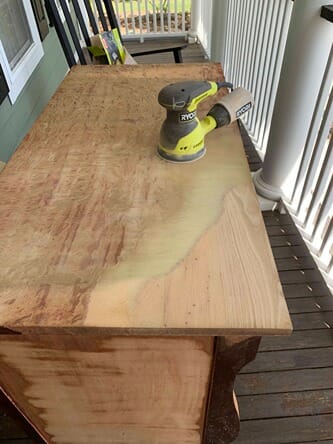
Step 1: Choose the Right Sandpaper
When it comes to sanding veneer, choosing the right sandpaper is crucial. It would be best to use fine-grit sandpaper, such as 220-grit, to avoid scratching or damaging the veneer’s surface. Using coarse grit sandpaper can quickly sand through the veneer, causing irreparable damage.
Step 2: Sand with the Grain of the Wood
To avoid damaging the veneer, always sand with the grain of the wood. Sanding against the grain can cause the veneer to splinter or tear, ruining the furniture’s appearance. Use light, even pressure, and keep the sandpaper moving back and forth.
Step 3: Use a Sanding Block or Orbital Sander
Use a sanding block or an orbital sander to ensure even sanding and avoid uneven spots. These tools will help to distribute the pressure evenly, preventing you from sanding too hard in one spot. When using an orbital sander, be careful not to apply too much pressure, which can cause the veneer to sand off.
Step 4: Test on a Small Area First
Before sanding the entire piece of furniture, it’s a good idea to test on a small, inconspicuous area first. This will allow you to see how the veneer will react to sanding and how much pressure you can apply. Stop sanding immediately if the veneer starts to sand off or become damaged.
Step 5: Clean the Surface
After sanding the veneer, be sure to clean the surface thoroughly. Use a soft cloth or a vacuum cleaner to remove any dust or debris from the furniture’s surface. This will ensure the surface is clean and ready for staining or finishing.
Step 6: Stain or Finish the Furniture
Once you have sanded the veneer and cleaned the surface, you can stain or finish the furniture. If you want to stain the furniture, make sure that you choose a stain that is compatible with the type of veneer you have. You can also apply a finish, such as a varnish or lacquer, to protect the furniture’s surface.
4 Types of Veneer and their uses
If you’re looking for a way to add a touch of luxury and sophistication to your furniture or interior design project, the veneer can be an excellent choice. But did you know that there are different types of veneer available? Here are some of the most common types:
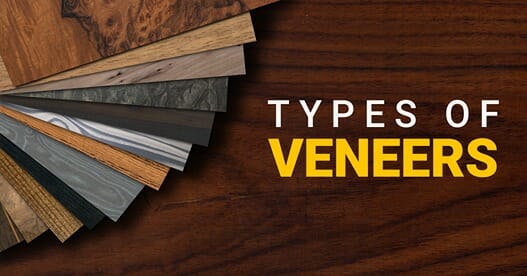
1: Rift Cut Veneer
Rift cut veneer is produced by cutting the log at a slight angle to the growth rings, resulting in a unique linear grain pattern. This type of veneer is often used for contemporary furniture designs and has a modern, minimalist look.
2: Rotary Lathe Cutting Veneer
The rotary lathe cutting veneer is made by peeling the log into thin sheets using a rotating lathe. This type of veneer is the most common and affordable, often used for mass-produced furniture and cabinetry.
3: Plain Sliced Veneer
A plain-sliced veneer is created by slicing the log into thin sheets perpendicular to the growth rings. This results in a classic, natural wood grain pattern often used in traditional furniture and cabinetry.
4: Quarter Sliced Veneer
A quarter-sliced veneer is created by cutting the log into quarters and then slicing it perpendicular to the growth rings. This results in a straight, uniform grain pattern often used for high-end furniture and decorative paneling.
Sanding a veneer – Cheat Sheet:
| Wood Type | Veneer Dimensions | Sanding Method | Sandpaper Grit |
| Maple | 12″ x 24″ x 1/16″ | Hand Sanding | 220 |
| Cherry | 10″ x 20″ x 1/32″ | Orbital Sander | 180 |
| Mahogany | 8″ x 16″ x 1/64″ | Belt Sander | 120 |
| Oak | 6″ x 12″ x 1/128″ | Sanding Block | 320 |
| Walnut | 4″ x 8″ x 1/256″ | Hand Sanding | 400 |
5 Types of Wood Veneer and How to sand them
As someone with a lot of experience in sanding veneer furniture, I know many different types of veneer are available. Each type of veneer has unique characteristics, which can affect how it is sanded and finished. In this article, I will discuss five types of veneer and provide some tips on effectively sanding each type.

1: Oak Veneer
Oak veneer is a popular furniture choice known for its beautiful grain pattern. When sanding oak veneer, it’s important to use fine-grit sandpaper, such as 220-grit, to avoid sanding through it. Sand with the grain of the wood, and use a sanding block or an orbital sander to ensure even sanding.
2: Maple Veneer
Maple veneer is another popular furniture choice known for its light color and subtle grain pattern. When sanding maple veneer, use fine-grit sandpaper and sand with the grain of the wood. Be careful not to sand too aggressively, which can cause the veneer to sand off. After sanding, clean the surface thoroughly before staining or finishing.
3: Walnut Veneer
Walnut veneer is a beautiful and durable option for furniture. When sanding walnut veneer, use fine-grit sandpaper and sand with the grain of the wood. Be careful not to sand through the veneer, which can cause irreparable damage. After sanding, clean the surface thoroughly and apply a stain or finish to protect the surface.
4: Mahogany Veneer
A mahogany veneer is a luxurious furniture option known for its rich, reddish-brown color. When sanding mahogany veneer, use fine-grit sandpaper and sand with the wood grain. Be careful not to sand too aggressively, which can cause the veneer to sand off. After sanding, clean the surface thoroughly and apply a finish to protect the surface.
5: Birch Veneer
Birch veneer is a light-colored furniture option known for its subtle grain pattern. When sanding birch veneer, use fine-grit sandpaper and sand with the grain of the wood. Be careful not to sand through the veneer, which can cause irreparable damage. After sanding, clean the surface thoroughly and apply a stain or finish to protect the surface.
What are alternatives to sanding veneer?
While sanding is a popular method for refinishing veneer furniture, it’s not always the best option. Sanding can be time-consuming and messy and even damage the veneer if not done properly.
Luckily, alternative methods for refinishing veneer furniture can yield excellent results. In this article, I will discuss alternative methods for sanding veneer furniture.

1: Chemical Stripping
Chemical stripping is a method for removing old finishes from veneer furniture. This method involves applying a chemical stripper to the furniture’s surface and allowing it to sit for a specified time.
The old finish will bubble and peel away from the surface and can then be scraped off with a plastic scraper. Chemical stripping is a fast and effective method for removing old finishes without damaging the veneer.
2: Painting
Painting can be a great alternative to sanding if your veneer furniture is damaged or has an
outdated finish. To paint veneer furniture, you’ll need to clean the surface thoroughly and apply a primer designed for use on non-porous surfaces like veneer. Once the primer has dried, apply your desired paint color with a brush or sprayer.
3: Staining
If you want to change the color of your veneer furniture, staining is a great alternative to sanding. Staining involves applying a stain to the veneer’s surface, which will soak into the wood and change its color. To stain veneer furniture, you must clean the surface thoroughly and apply the stain with a brush or rag.
4: Veneer Patching
If your veneer furniture has small chips or cracks, veneer patching can be a great alternative to sanding. Veneer patching involves cutting a small veneer to match the damaged area, gluing it in place, and sanding it down to match the surrounding veneer.
3 different methods of sanding veneer.
Sanding veneer furniture can be tricky, as the thin veneer layer can easily be sanded through. However, several methods can be used to sand veneers successfully without causing damage. This article will cover three different methods for sanding veneer furniture.
1: Hand Sanding:
Hand sanding is the most gentle way to sand veneer, allowing precise control over the sanding process. To begin, choose a fine-grit sandpaper, such as 220-grit, and fold it in half to create a small sanding block. Hold the sanding block at a 45-degree angle to the veneer surface and sand in the direction of the grain.
2: Wet Sanding:
Wet sanding is another gentle method for sanding veneer, as the water helps to lubricate the sandpaper and prevent it from cutting too deeply into the veneer. To wet sand, soak a piece of 220-grit sandpaper in water for several minutes, then place it on the veneer surface. Using a circular motion, sand the surface, careful not to sand through the veneer.
3: Orbital Sanding:
Orbital sanders are power tools that use a circular motion to sand surfaces. While they can be more aggressive than hand or wet sanding, they can still be used to sand veneer if the right precautions are taken. To use an orbital sander on the veneer, choose a fine-grit sandpaper, such as 220-grit, and attach it to the sander.
Are you confusing veneer with laminate? Here is a difference.
Regarding furniture and interior design, veneer and laminate are two common materials that people often mistake for one another. While both have their unique properties, some significant differences set them apart. This article will discuss the difference between a veneer and laminate in 5 points.
| Factors | Veneer | Lamination |
| Definition | Thin layer of real wood sliced from a log | Synthetic material made of paper or fabric impregnated with resin and bonded to a core |
| Production | Sliced or peeled from logs | Manufactured in sheets |
| Thickness | Usually less than 1/16″ thick | Typically 1/16″ to 1/8″ thick |
| Grain pattern | Natural wood grain pattern | Uniform pattern or design |
| Durability | Can be fragile and easily damaged | More durable and resistant to wear and tear |
| Cost | Generally more expensive | Generally less expensive |
| Repair | Can be sanded and refinished | Cannot be sanded and must be replaced if damaged beyond repair |
1: Composition:
One of the most significant differences between veneer and laminate is their composition. Veneer is made from real wood and is a thin slice of hardwood attached to a solid core. On the other hand, laminate is made of multiple layers of paper or fabric that are impregnated with resin and bonded together under high pressure and heat.
2: Appearance:
Another difference between veneers and laminate is their appearance. Veneer has a natural and unique grain pattern inherent in the wood species. On the other hand, laminate is an artificial product that can mimic the appearance of natural materials, such as wood or stone. Still, it lacks the natural variation and uniqueness of real wood veneer.
3: Durability:
Veneer and laminate also differ in terms of their durability. Veneer is generally more durable than laminate because it is made of real wood and can withstand wear and tear for longer. Laminate, on the other hand, is susceptible to scratching and chipping, especially around the edges.
4: Maintenance:
Maintenance is another aspect where veneer and laminate differ. Veneer can be sanded and refinished if damaged or worn, while laminate cannot be sanded and refinished. Laminate is also less resistant to moisture and heat than veneer, making it more susceptible to warping and swelling.
5: Cost:
Finally, the cost of veneer and laminate significantly differs between the materials. Veneer is generally more expensive than laminate because it is made from real wood, a natural resource that requires harvesting and processing. On the other hand, laminate is a more affordable alternative that can mimic the look of real wood at a lower cost.
What are the steps to repair scratched or faded wood veneer?
Wood veneer is a popular choice for furniture because of its beauty and durability. However, wood veneer can become scratched or faded over time, making your furniture look old and worn out. Fortunately, repairing wood veneer is not difficult and can be done using a few simple steps.

Step 1: Clean the Surface
The first step in repairing scratched or faded wood veneer is thoroughly cleaning the surface. Use a damp cloth to wipe down the surface and remove dirt or grime. Allow the surface to dry completely before moving on to the next step.
Step 2: Fill in Scratch
For small scratches in the veneer, use a wood filler to fill in the scratches. Apply the filler with a putty knife, then use sandpaper to smooth the surface. Start with a coarse grit sandpaper and work up to a finer grit.
Step 3: Sand the Surface
To remove the faded finish and smooth the surface, sand the veneer with a fine-grit sandpaper. Sanding will remove the old finish and expose a fresh surface for refinishing. Be careful not to sand through the veneer, which can cause irreparable damage.
Step 4: Stain the Veneer
After sanding, you can apply a stain to the veneer to restore its color. Choose a stain that matches the original color of the veneer. Apply the stain with a brush or cloth, and wipe away any excess with a clean cloth. Allow the stain to dry completely before moving on to the next step.
Step 5: Apply a Protective Finish
To protect the newly refinished veneer, apply a protective finish. You can use polyurethane, lacquer, or another type of finish that is suitable for wood. Apply the finish with a brush or cloth, following the manufacturer’s instructions. Allow the finish to dry completely before using the furniture.
Step 6: Buff the Surface
Once the finish is dry, buff the veneer’s surface with a soft cloth to remove any remaining imperfections. This will give your furniture a smooth and polished look.
Can You Sand Veneer? FAQs
If you have furniture made of veneer, you might be wondering whether or not it can be sanded. Here are some frequently asked questions on the topic:
Can You Sand Veneer?
Yes, you can sand veneer. However, it’s important to take care not to sand through the veneer layer, as this can damage the piece of furniture beyond repair.
How Do You Sand Veneer Furniture?
When sanding veneer furniture, it’s important to use a light touch and fine-grit sandpaper, such as 220-grit. Start with a small area and test your technique before moving on to the entire piece. Be sure to sand with the grain of the wood, and avoid pressing too hard on the sandpaper.
Can You Sand Off Veneer and Stain It?
It is possible to sand off the veneer, but it can be difficult and time-consuming. If you want to change the stain or color of the furniture, apply a new veneer or use a staining or painting technique that doesn’t require removing the existing veneer layer.
Conclusion
In conclusion, sanding veneer is possible but requires a delicate touch and careful attention to avoid sanding through the veneer layer. Remember, sanding veneer can be tricky, but it can be done successfully with the right tools and techniques. So, can you sand veneer? Yes, but approach the task with caution and precision.

Why Trust About Sanders?
When it comes to the world of sanding and sanders, you need a trusted source of information and guidance to ensure you achieve those perfect finishes. That's where I come in – I'm Martin, a dedicated sanding enthusiast with a relentless passion for attaining flawless surfaces. With years of hands-on experience in the sanding industry, I've honed my skills and expertise to provide you with the most reliable and accurate insights. What sets me apart is my commitment to excellence. I meticulously handpick each sander after rigorous testing, ensuring that only the best tools make it to your hands. My goal is to empower you with the knowledge and recommendations you need to tackle any sanding task confidently. When you trust About Sanders, you're putting your faith in a seasoned expert who shares your passion for perfection and strives to deliver top-notch information and reviews for every sanding challenge.
